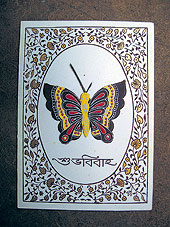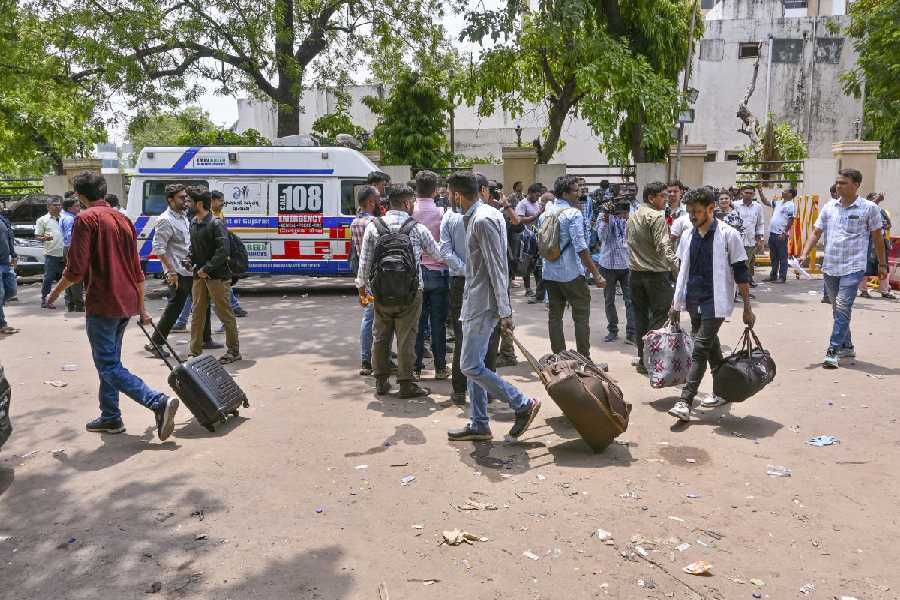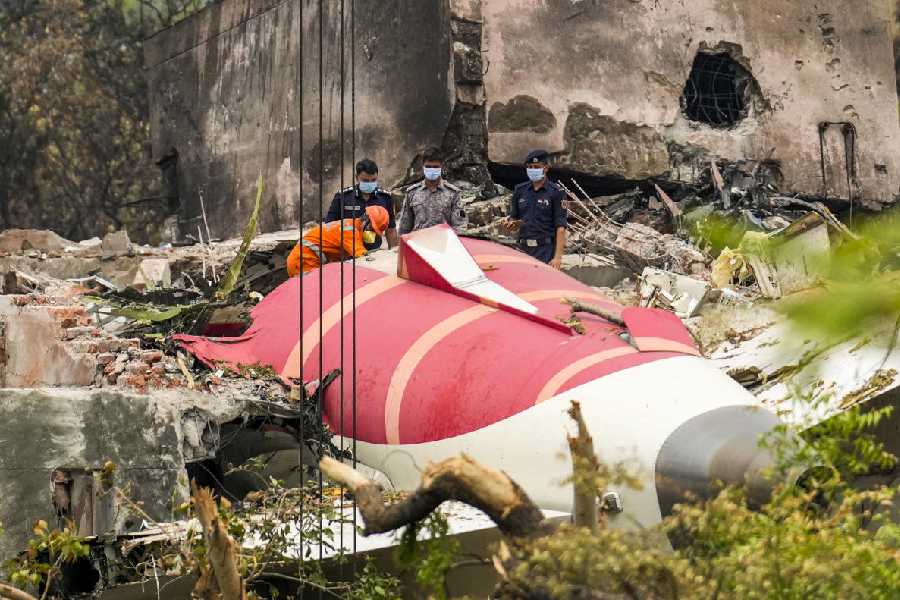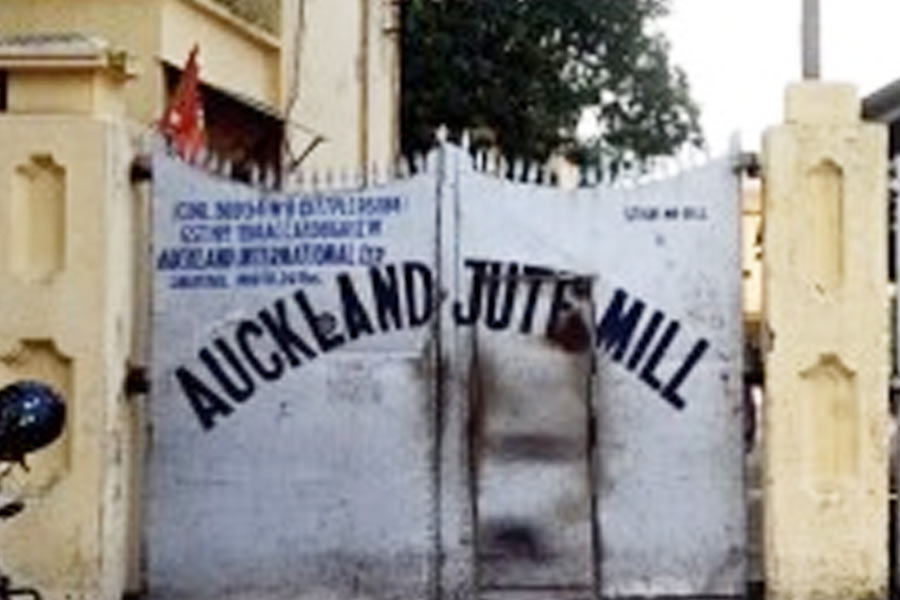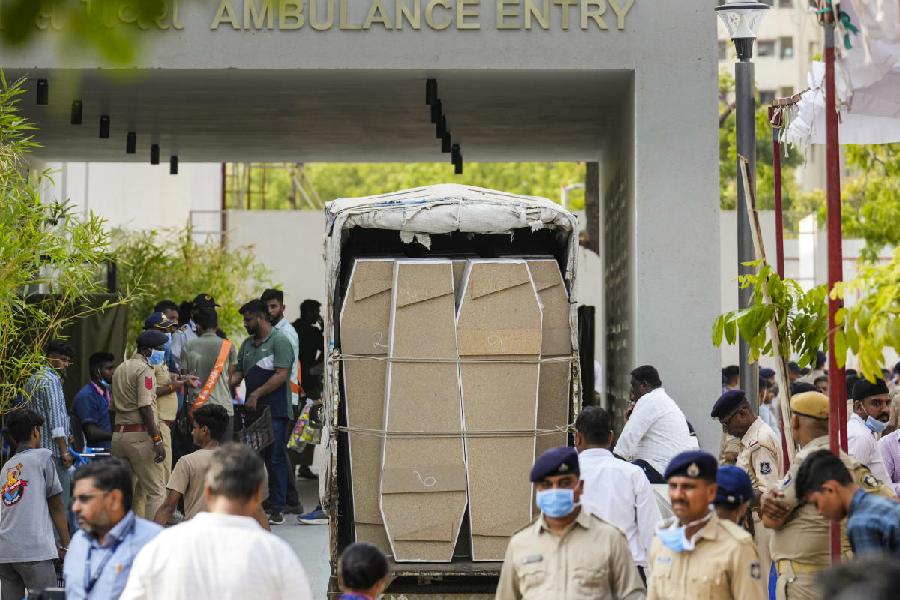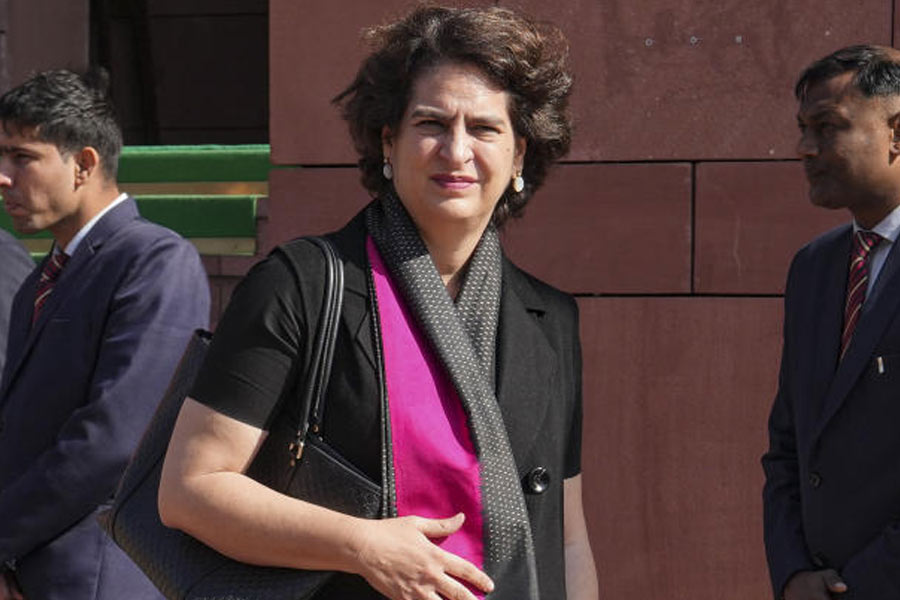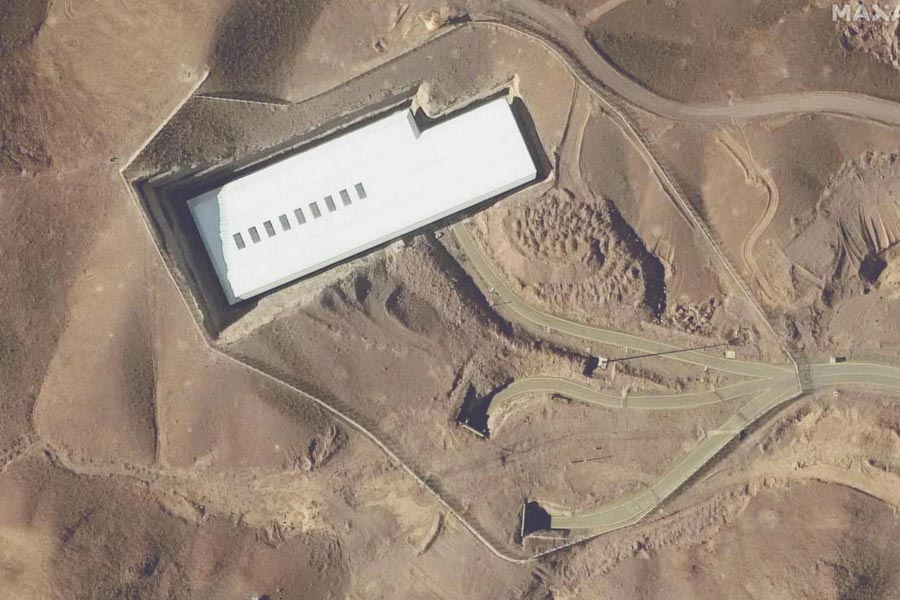| Then |
 |
 |
| Now |
 |
 |
 |
| Pictures by Bishwarup Dutta |
The story of the Bengali wedding card — from humble origin to designer dazzle
The display window of Prayojani in College Street is crowded with invitation cards. A blend of pink and mauve with silver glitter, gold brocade paper with golden zari border and a sketch of a bride in gold with her bindi being the only touch of red. There are cards in the shape of a palki or a big, old, ornate, hand-held pakha or those shaped like manuscripts or khatas with a golden thread running through their spine.
With Poila Baisakh, the wedding season is here. To be followed by a slew of wedding cards as ornate as the kantha-stitch kurtas Bengali men love to flaunt at weddings.
Wedding cards are a mini industry now. “Ten years ago, there were only 73 card shops in the stretch between College Street and Sealdah. Today there are 173,” says Baridbaran Ghosh, who has written a book titled Amantran-Nimantran on the evolution of invitation cards. The spend on cards in the wedding budget has shot up. The price of a card starts at Rs 8 to Rs 9 and can go up to Rs 30. “The price has gone up almost by 50 per cent in three years,” says Sudesh Kumar Sharma of Prayojani.
About 80 years ago, when the first Bengali Hindu wedding card is said to have been despatched, things were different. Between the covers of the new-age card lies the story of how marriage, the great Bengali social institution, has changed.
Wedding cards have become more important in Muslim weddings. Previously, a visit to the guest was enough as invitation. Now a card is essential.
Shimmer and shine
The most rapid makeover has taken place in the last three or four years. “Earlier the cards were mostly red. Every colour apart from black sells. The quality of the cards has improved. Handmade paper is in,” says Sharma. Simplicity is passe, replaced by cards worked with golden foil, silver foil, artificial zari.
Akbar Husain, a software engineer, attended a relative’s wedding where the card included a calendar and a cricket schedule.
Gopal Ray of New Classic Cards has on display cards with murals, sketches and paintings, folk art and Madhubani paintings. “I started experimenting two to three years ago,” he says.
The lettering, too, has changed. “Clients want the ‘hand-written’ look and no printed words. Computers have made it easy to get that,” says Sharma.
British legacy
Not so long ago, wedding cards were unheard of. “Wedding cards are not an integral part of our culture. It is something we picked up from the British,” says Sachindra Mohun Gupta of Papyrus, a shop that has been supplying paper for wedding cards for decades and specialises in hand-made paper.
“Previously invitation was by word of mouth. It is still the same in the villages. If someone lived at a distance, a postcard would be sent,” he adds.
Ghosh believes the first wedding card in Bengal was printed after the first World War, following which there was greater interaction between the British and the “native”.
“The first card was probably sent during the second marriage of Dinendranath Tagore that took place after the war. The first cards were very simple — just the invitation, either hand-written or printed, with a small picture of a butterfly or an auspicious symbol,” says Ghosh.
Roka
Written invitations had existed before that. The tradition of wedding letters started with a maharaja of Tripura. “Roka (an Arabic word that passed into Bengali) was the written intimation of a wedding. A turmeric mark would be put on the paper. In 1555, the maharaja of Tripura had sent the maharaja of Assam a proposal of marriage between the two families. It was a beautifully written letter and started the tradition,” Ghosh adds.
In the absence of an envelope, the letter itself would be folded and sealed. The address would begin with “projapati”, symbolising Brahma and other gods who nurture life.
“Though wedding cards were adopted from the British, the tradition of biyer podyo (wedding poem) was part of our culture. These were written by both the families of the bride and the groom and would bless the young couple, or tease the family,” says Gupta.
Anything related to a wedding was written in red ink. “The letters that Vidyasagar wrote during the first widow remarriage were also written in red ink. Another famous wedding letter was the one that Rabindranath wrote for his own wedding. Nazrul had written one in anticipation of his wedding, but unfortunately the marriage didn’t take place,” says Ghosh.
WW I and peace
The World War also prompted the bilingual card. The trend of sending invitation cards had started among the elite families. After the war, the British would be invited more to weddings in such families, and the invitation would be in English and Bengali.
The common man adopted the wedding card only in the 1950s, with a boom in the print industry. “The printing presses popularised wedding cards. They supplied the paper and advised on the text,” says Ghosh.
Magic carpet
Says Anasuya Mukherjee, a housewife in her late 40s: “I remember the cards that were made for my uncles’ wedding. They were in the shape of a banana or ashwattha (peepul) leaf and with a butterfly or some other motif.”
Magician P.C. Sorcar Jr has similar memories. “My father’s wedding card was the size of a postcard. It had a picture of a butterfly and had ‘Om Prajapataye Namah’ written on top,” he says. But Sorcar Jr’s wedding card was far more fanciful. “It was big and showed me on a magic carpet flying towards a palace where a princess (my wife-to-be) awaited me. Behind me was a long train of friends on horses, elephants and in cars. The card had been sketched by artist Shaila Chakraborty.”
Different
Artist Ranen Ayan Dutta became a trend-setter with his hand-written cards, where the monotony of writing was broken by the sketch of a butterfly, kalash or some such auspicious sign. Other artists, too, like Ganesh Pyne, M.F. Husain and even Satyajit Ray, are said to have designed cards for friends. But the mass-produced cards, available at the shops, remained more or less the same, till recently.
A card-seller attributed the change to the growing sense of competition. “As with the house, car and AC, so with the wedding card,” he says.
A few old cards lie scattered in the shops. “These are now mainly for the rural clientele,” says Sharma. Till e-mail and SMS become acceptable Bengali norms of invitation, the designer wedding card rules.
calling all friends
 |
| Tagore’s wedding invitation |
“My wedding card was very simple. It was on yellow hand-made paper and the language, though a little experimental, was simple. It was a ‘love marriage’. I could not afford to spend much on the card. I had written the invitation, though my father was named as the host and I had described myself as chhele and not putra. These days you get cards with even diamonds on it that cost Rs 50,000. But I find such a display in bad taste”: Buddhadeb Guha, writer.
“In those days I did not earn enough. My card was made by my artist friend Prithvish Gangopadhyay. What was more interesting were the many biyer podyos written on pink paper that my friends had written for us. In the past, those who had left Bangladesh long back would mention Dhaka or a place in Bangladesh as their original home. Now that generation has passed and that style of invitation too”: Sunil Gangopadhyay, writer.

